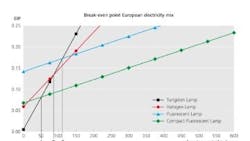CFL life cycle called energy efficient
When viewed over the entire production-to-disposal lifecycle, compact fluorescent lamps (CFLs) are more efficient than other types of light sources. At least that is the claim of researchers at Empa, an interdisciplinary research and services institution for material sciences and technology development located in Switzerland.
Empa’s Technology and Society Laboratory examined several different lighting methods to find out which source of illumination is the most environmentally friendly. However, their investigation notably did not include LEDs. They investigated the classical incandescent bulb, halogen lamps, fluorescent tubes and CFLs. Researchers prepared a life cycle analysis for each kind that considered the raw material and energy consumption of a lamp during its complete life cycle, from the production and usage to final disposal.
Empa scientists say the proportion of the total environmental effects caused by the production of all the lamps was small. Using the Swiss electrical power mix as a basis, the manufacture of an incandescent bulb, for example, was responsible for just 1% of its total environmental effect. By comparison, the production of an energy saving lamp at 15% of the total is significantly higher, because they contain a built-in electronic ballast.Using the European power mix (which includes a significant fraction of electricity generated by coal fired power stations) as a basis for calculation leads to much lower values for incandescent bulbs and energy saving lamps of 0.3% and 4% respectively.
Researchers say the method of disposal of the lamps at the end of their useful life is also not an important factor in the overall ecobalance calculation. In fact, in the case of CFLs the environmental effects reduce by as much as 15% when they are recycled instead of being incinerated. But even when they are
incinerated in a waste disposal facility the much criticized mercury release is quantitatively insignificant because the overwhelming proportion of mercury in the environment is emitted by fossil-fuel-burning power stations.
Using the European power mix, which is produced mainly by fossil fuel powered generation plants, both incandescent lamps and CFLs reach their environmental break-even points quickly - after some 50 hours - because of the significantly higher power consumption of the tungsten filament bulb. With the Swiss power mix this point is reached after 187 hours. But with a typical
lifetime of about 10,000 hours for a compact fluorescent energy saving lamp (compared to some 1,000 hours for an incandescent bulb), the purchase of such a lamp pays for itself quickly in an ecological sense, they say.
More info:
http://www.alphagalileo.org/AssetViewer.aspx?AssetId=35627&CultureCode=en
